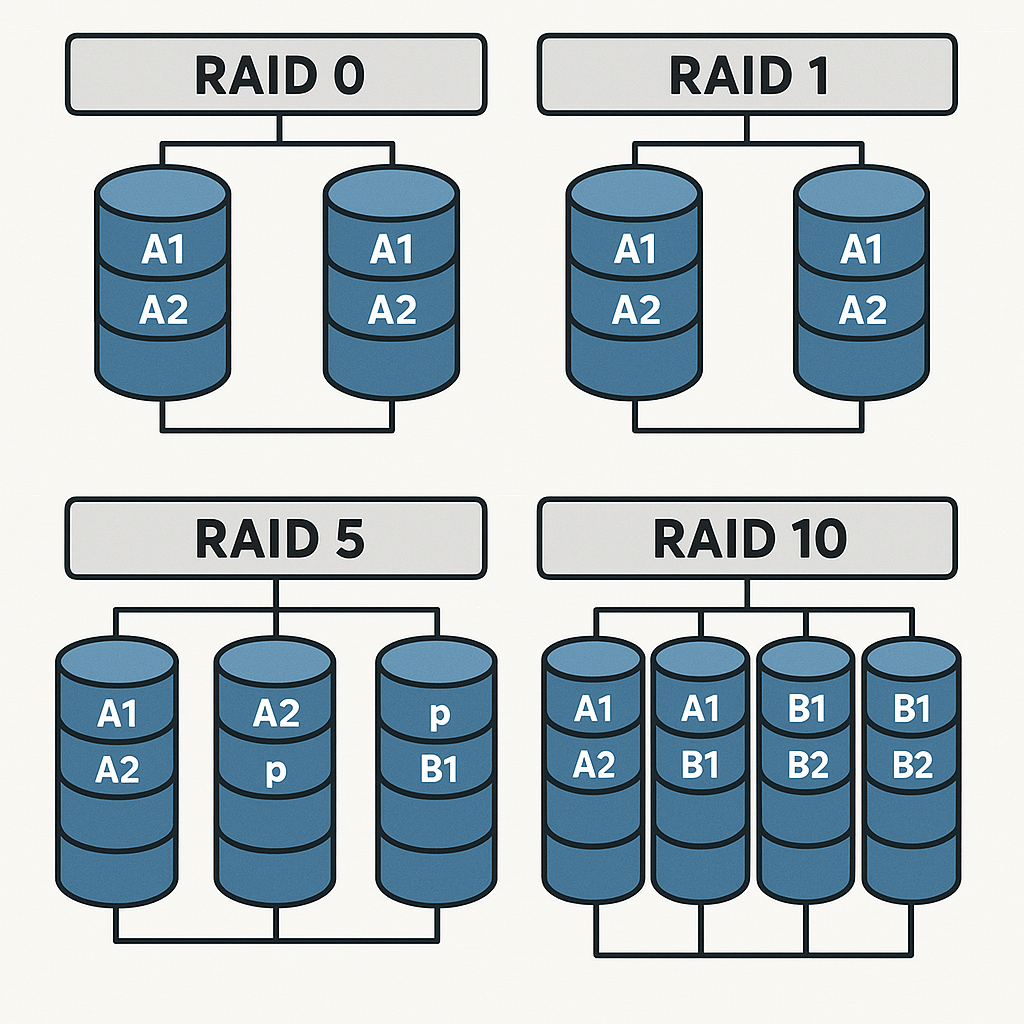
A RAID server is a server that uses a RAID (Redundant Array of Independent Disks) configuration to manage multiple hard drives as a unified storage system. It enhances performance, fault tolerance, or both, depending on the RAID level used.
🔧 What a RAID Server Does:
- Combines multiple physical drives into a single logical unit
- Distributes data across these drives using various techniques (striping, mirroring, parity)
- Protects data against drive failure (depending on RAID level)
- Improves performance by allowing simultaneous read/write operations
🖥️ Why RAID is Used in Servers:
| Purpose | Benefit |
|---|---|
| Redundancy | Prevents data loss during disk failure (RAID 1, 5, 10, etc.) |
| Performance | Increases speed by spreading data across multiple drives (RAID 0, 10) |
| Scalability | Adds more drives to expand storage easily |
| Availability | Keeps services online even if a disk fails |
🧱 Where RAID Is Used:
- Web and database servers
- File servers and NAS
- Virtualization hosts
- Backup and storage appliances
- The list goes on……
🔄 Software vs. Hardware RAID Servers:
- Software RAID: Managed by the operating system (lower cost, flexible)
- Hardware RAID: Managed by a RAID controller card (faster, more reliable, especially in enterprise)
Here’s a breakdown of the most common RAID (Redundant Array of Independent Disks) types used in servers, including their advantages and disadvantages:
RAID 0 – Striping
Description:
Data is split evenly across two or more disks (striped), with no redundancy.
- Minimum Disks: 2
- Fault Tolerance: None
- Performance: High read/write speed
Advantages:
- Fast performance (reads/writes in parallel)
- 100% disk capacity usable
Disadvantages:
- No fault tolerance (if one disk fails, all data is lost)
- Not suitable for critical data
RAID 1 – Mirroring
Description:
Data is duplicated (mirrored) across two disks.
- Minimum Disks: 2
- Fault Tolerance: High (can survive one disk failure)
- Performance: Good read speed, slower writes
Advantages:
- Simple and reliable
- Easy to recover from failure
- Faster reads (read from either disk)
Disadvantages:
- 50% storage efficiency (one disk is always a mirror)
- Higher cost due to duplication
RAID 5 – Striping with Parity
Description:
Data and parity (error correction) are striped across 3 or more disks. Parity allows data recovery if one disk fails.
- Minimum Disks: 3
- Fault Tolerance: Can survive one disk failure
- Performance: Balanced; good read, slower write
Advantages:
- Efficient use of space (only one disk used for parity)
- Fault tolerance without full mirroring
- Good read performance
Disadvantages:
- Slower write performance due to parity calculations
- Recovery after failure can be slow and risky under load
RAID 10 (1+0) – Mirroring + Striping
Description:
Combines RAID 1 and RAID 0: striped sets mirrored for redundancy.
- Minimum Disks: 4
- Fault Tolerance: High (can survive multiple disk failures, depending on which disks)
- Performance: High read/write speed
Advantages:
- High performance
- High redundancy
- Faster rebuilds than RAID 5
Disadvantages:
- 50% storage efficiency (half the drives are used for mirroring)
- More expensive (requires more drives)
Linked article:
